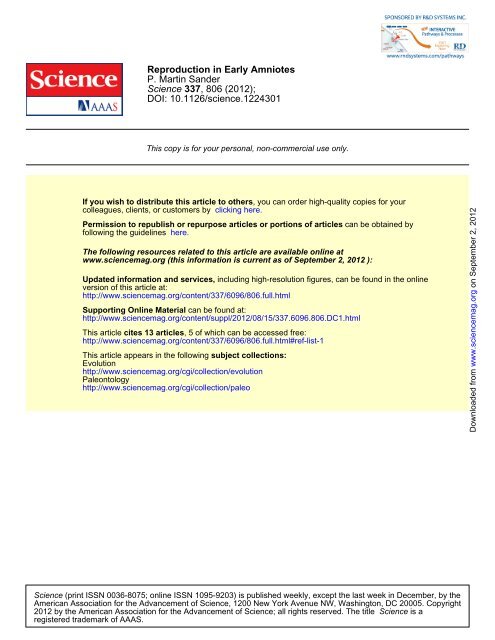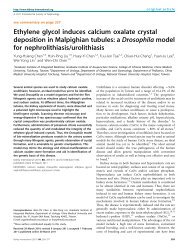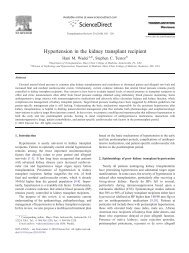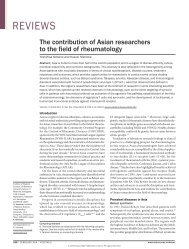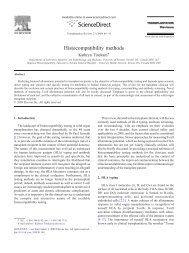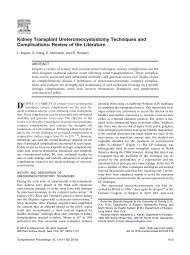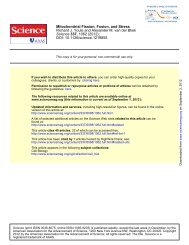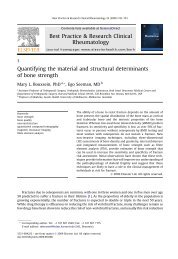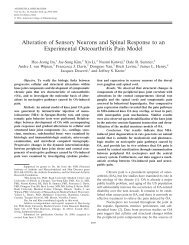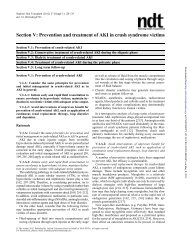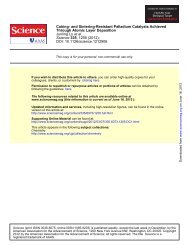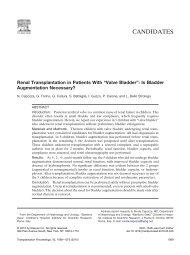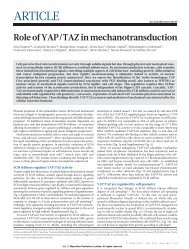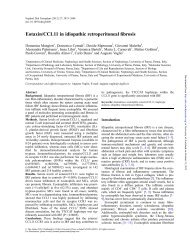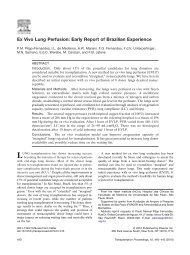Reproduction in Early Amniotes
Reproduction in Early Amniotes
Reproduction in Early Amniotes
You also want an ePaper? Increase the reach of your titles
YUMPU automatically turns print PDFs into web optimized ePapers that Google loves.
<strong>Reproduction</strong> <strong>in</strong> <strong>Early</strong> <strong>Amniotes</strong><br />
P. Mart<strong>in</strong> Sander<br />
Science 337, 806 (2012);<br />
DOI: 10.1126/science.1224301<br />
This copy is for your personal, non-commercial use only.<br />
If you wish to distribute this article to others, you can order high-quality copies for your<br />
colleagues, clients, or customers by click<strong>in</strong>g here.<br />
Permission to republish or repurpose articles or portions of articles can be obta<strong>in</strong>ed by<br />
follow<strong>in</strong>g the guidel<strong>in</strong>es here.<br />
The follow<strong>in</strong>g resources related to this article are available onl<strong>in</strong>e at<br />
www.sciencemag.org (this <strong>in</strong>formation is current as of September 2, 2012 ):<br />
Updated <strong>in</strong>formation and services, <strong>in</strong>clud<strong>in</strong>g high-resolution figures, can be found <strong>in</strong> the onl<strong>in</strong>e<br />
version of this article at:<br />
http://www.sciencemag.org/content/337/6096/806.full.html<br />
Support<strong>in</strong>g Onl<strong>in</strong>e Material can be found at:<br />
http://www.sciencemag.org/content/suppl/2012/08/15/337.6096.806.DC1.html<br />
This article cites 13 articles, 5 of which can be accessed free:<br />
http://www.sciencemag.org/content/337/6096/806.full.html#ref-list-1<br />
This article appears <strong>in</strong> the follow<strong>in</strong>g subject collections:<br />
Evolution<br />
http://www.sciencemag.org/cgi/collection/evolution<br />
Paleontology<br />
http://www.sciencemag.org/cgi/collection/paleo<br />
Downloaded from www.sciencemag.org on September 2, 2012<br />
Science (pr<strong>in</strong>t ISSN 0036-8075; onl<strong>in</strong>e ISSN 1095-9203) is published weekly, except the last week <strong>in</strong> December, by the<br />
American Association for the Advancement of Science, 1200 New York Avenue NW, Wash<strong>in</strong>gton, DC 20005. Copyright<br />
2012 by the American Association for the Advancement of Science; all rights reserved. The title Science is a<br />
registered trademark of AAAS.
PERSPECTIVES<br />
<strong>in</strong>creas<strong>in</strong>g the activity of specific K + channels,<br />
which reduced excitability <strong>in</strong> the neurons.<br />
Dur<strong>in</strong>g the day, the reduced state shuts<br />
down some K + -channel activity while modulat<strong>in</strong>g<br />
the conductances of others, thereby<br />
<strong>in</strong>creas<strong>in</strong>g excitability <strong>in</strong> these cells.<br />
Because clock gene transcription is itself<br />
sensitive to redox state, the study by Wang et<br />
al. and recent work <strong>in</strong> other circadian systems<br />
provide evidence for a metabolically sensitive,<br />
nontranscriptional pathway to temporally<br />
sculpt the clock’s transcriptional and electrical<br />
mach<strong>in</strong>ery (see the figure). However, further<br />
work is necessary to establish how, for example,<br />
clamp<strong>in</strong>g the redox state at an <strong>in</strong>termediate<br />
level affects the molecular clockwork and<br />
its eventual electrical output. Also, confirm<strong>in</strong>g<br />
the observations of Wang et al. and others <strong>in</strong><br />
vivo will be challeng<strong>in</strong>g. Because SCN cells<br />
do not exist <strong>in</strong> isolation but are part of a network<br />
of tightly packed neurons that can <strong>in</strong>fluence<br />
the activity of one another, the question<br />
of whether metabolic state is the cause or the<br />
result of neuronal activity rema<strong>in</strong>s unclear.<br />
Nevertheless, the results of Wang et al.<br />
and the ideas they propose are consistent<br />
with several f<strong>in</strong>d<strong>in</strong>gs that challenge an exclusive<br />
TTFL model of the molecular clock.<br />
PALEONTOLOGY<br />
<strong>Reproduction</strong> <strong>in</strong> <strong>Early</strong> <strong>Amniotes</strong><br />
P. Mart<strong>in</strong> Sander<br />
The conquest of dry land by vertebrate<br />
animals began with the evolution<br />
of the first four-legged, amphibious<br />
animals ~360 million years ago ( 1, 2).<br />
<strong>Amniotes</strong> orig<strong>in</strong>ated ~50 million years later<br />
( 1) and have s<strong>in</strong>ce become the most diverse<br />
clade of land-liv<strong>in</strong>g vertebrates, <strong>in</strong>clud<strong>in</strong>g<br />
mammals, turtles, lizards, snakes, crocodiles,<br />
and birds. Evolutionary changes <strong>in</strong><br />
reproduction were crucial for the move from<br />
the sea via swamps to dry land. However,<br />
the reproductive structures and early life<br />
stages of amniotes fossilize poorly. Exceptional<br />
<strong>in</strong>sights <strong>in</strong>to early amniote reproduction<br />
are offered by recent fossil discoveries<br />
( 3– 6). The fact that these fossils come from<br />
ancient seas and lakes and not from dry land<br />
helps to expla<strong>in</strong> the paradox that there is an<br />
older fossil record for live-bear<strong>in</strong>g amniotes<br />
than for egg lay<strong>in</strong>g <strong>in</strong> amniotes.<br />
Ste<strong>in</strong>mann Institute of Geology, M<strong>in</strong>eralogy, and Paleontology,<br />
Division of Paleontology, University of Bonn, Nussallee 8,<br />
53115 Bonn, Germany. E-mail: mart<strong>in</strong>.sander@uni-bonn.de<br />
The key evolutionary <strong>in</strong>novation that<br />
enabled amniotes to colonize habitats away<br />
from water was the cleidoic egg. Its complex<br />
structure added extraembryonic membranes<br />
(the chorion and the amnion) and a shell to<br />
the primitive vertebrate egg design with its<br />
embryo, yolk, and jelly layers ( 2). These<br />
membranes and eggshell enable egg lay<strong>in</strong>g<br />
and development on dry land. The shell and<br />
egg membranes allow gas exchange to and<br />
from the develop<strong>in</strong>g embryo, lett<strong>in</strong>g oxygen<br />
<strong>in</strong> and carbon dioxide out but reta<strong>in</strong><strong>in</strong>g<br />
water. The shell may be either leathery or<br />
calcified. Phylogenetic <strong>in</strong>ference shows that<br />
leathery shells evolved first; calcified eggshells<br />
evolved <strong>in</strong>dependently from leathery<br />
eggshells at least four times (see the figure).<br />
The evolution of the cleidoic egg had two<br />
ma<strong>in</strong> effects. One was <strong>in</strong>ternal fertilization.<br />
The other was that eggs could no longer be<br />
laid <strong>in</strong> water, where the embryo would suffocate.<br />
This had major implications for the<br />
secondarily mar<strong>in</strong>e amniotes that frequently<br />
evolved from terrestrial l<strong>in</strong>eages.<br />
Recent research has shown that peroxiredox<strong>in</strong>s,<br />
prote<strong>in</strong>s that are present <strong>in</strong> virtually all<br />
liv<strong>in</strong>g organisms and that function to buffer<br />
the <strong>in</strong>tracellular environment, undergo daily<br />
rhythms of oxidation-reduction across a<br />
range of species, <strong>in</strong>clud<strong>in</strong>g those whose cells<br />
are enucleated ( 2– 4). There are similarities<br />
here also to the circadian clock <strong>in</strong> cyanobacteria,<br />
which do not employ the TTFL clock,<br />
as well as the clock <strong>in</strong> plants, which has both<br />
TTFL and non-TTFL components ( 14, 15).<br />
Thus, it seems that across many life forms,<br />
TTFL and non-TTFL timekeep<strong>in</strong>g processes<br />
are not mutually exclusive, and <strong>in</strong> mammals,<br />
they cooperate to orchestrate circadian output<br />
of clock neurons.<br />
Although several K + channels <strong>in</strong> the<br />
SCN show circadian variation <strong>in</strong> the abundance<br />
of their transcripts and <strong>in</strong> their functional<br />
activity, the study by Wang et al.<br />
illustrates how focus<strong>in</strong>g on a direct l<strong>in</strong>k<br />
between the activity of these channels and<br />
the molecular clockwork may have discouraged<br />
the consideration of other important<br />
possibilities. Indeed, because neurons and<br />
subregions of the SCN are heterogeneous,<br />
it will be important to determ<strong>in</strong>e if redox<br />
state differentially <strong>in</strong>fluences SCN neuron<br />
activity. Similarly, because other bra<strong>in</strong><br />
regions that <strong>in</strong>fluence metabolic physiology<br />
may also conta<strong>in</strong> a TTFL molecular clock<br />
( 16), the <strong>in</strong>fluence of redox state on cellular<br />
activity <strong>in</strong> these neural structures should be<br />
analyzed as well.<br />
References<br />
1. K. M. Ramsey et al., Science 324, 651 (2009).<br />
2. J. S. O’Neill, A. B. Reddy, Nature 469, 498 (2011).<br />
3. J. S. O’Neill et al., Nature 469, 554 (2011).<br />
4. R. S. Edgar et al., Nature 485, 459 (2012).<br />
5. T. A. Wang et al., Science 337, 839 (2012);<br />
10.1126/science.1222826.<br />
6. T. M. Brown, H. D. Pigg<strong>in</strong>s, Prog. Neurobiol. 82, 229<br />
(2007).<br />
7. M. D. Belle, C. O. Diekman, D. B. Forger, H. D. Pigg<strong>in</strong>s,<br />
Science 326, 281 (2009).<br />
8. C. S. Colwell, Nat. Rev. Neurosci. 12, 553 (2011).<br />
9. E. D. Herzog, J. S. Takahashi, G. D. Block, Nat. Neurosci.<br />
1, 708 (1998).<br />
10. H. Albus et al., Curr. Biol. 12, 1130 (2002).<br />
11. Q. J. Meng et al., Neuron 58, 78 (2008).<br />
12. M. N. Nitabach, J. Blau, T. C. Holmes, Cell 109, 485<br />
(2002).<br />
13. W. J. Schwartz, <strong>in</strong> Suprachiasmatic Nucleus: The M<strong>in</strong>d’s<br />
Clock, D. C. Kle<strong>in</strong>, R. Y. Moore, S. M. Reppert, Eds.<br />
(Oxford Univ. Press, New York, 1991), pp. 144–156.<br />
14. M. Nakajima et al., Science 308, 414 (2005).<br />
15. A. N. Dodd et al., Science 318, 1789 (2007).<br />
16. C. Guild<strong>in</strong>g, A. T. Hughes, T. M. Brown, S. Namvar,<br />
H. D. Pigg<strong>in</strong>s, Mol. Bra<strong>in</strong> 2, 28 (2009).<br />
10.1126/science.1227203<br />
Recent fossil f<strong>in</strong>ds help to expla<strong>in</strong> why<br />
the early fossil record is dom<strong>in</strong>ated by<br />
live-bear<strong>in</strong>g amniotes, although live-bear<strong>in</strong>g<br />
amniotes evolved later than egg-lay<strong>in</strong>g ones.<br />
Soon after their orig<strong>in</strong>, Amniota split <strong>in</strong>to<br />
two major l<strong>in</strong>eages: the mammal-l<strong>in</strong>e amniotes<br />
(Synapsida) and the bird-l<strong>in</strong>e amniotes<br />
(Reptilia). Phylogenetic <strong>in</strong>ference from liv<strong>in</strong>g<br />
animals (see the figure) suggests that<br />
amniote egg lay<strong>in</strong>g evolved no later than <strong>in</strong><br />
the last common ancestor of mammals and<br />
birds, ~310 million years ago ( 1). Both animal<br />
groups have a cleidoic egg, although<br />
this has been lost <strong>in</strong> mammals more derived<br />
than monotremes. It is highly unlikely that<br />
this complex egg structure evolved more<br />
than once ( 2). Paleontologists have <strong>in</strong>ferred<br />
egg lay<strong>in</strong>g on dry land from skeletal <strong>in</strong>dicators<br />
of full terrestriality—such as welldeveloped<br />
limb jo<strong>in</strong>ts—<strong>in</strong> tetrapods close to<br />
the mammal-bird split ( 2).<br />
However, fossils of the cleidoic egg from<br />
near the mammal-bird split have been hard<br />
to come by. The oldest cleidoic egg fossils<br />
postdate amniote orig<strong>in</strong>s by 90 million years.<br />
At sites <strong>in</strong> Argent<strong>in</strong>a and South Africa, fossilized<br />
egg clutches and embryos of prosauropod<br />
d<strong>in</strong>osaurs have been found that are<br />
Downloaded from www.sciencemag.org on September 2, 2012<br />
806<br />
17 AUGUST 2012 VOL 337 SCIENCE www.sciencemag.org<br />
Published by AAAS
PERSPECTIVES<br />
Amniota<br />
FULLY TERRESTRIAL LIFESTYLE<br />
Reptilia<br />
Diapsida<br />
Lepidosauria<br />
220 million years and 188 million years old,<br />
respectively ( 7). The shells of these prosauropod<br />
eggs are very th<strong>in</strong> but sufficiently m<strong>in</strong>eralized<br />
to fossilize. This suggests that calcified<br />
eggshell had to evolve before the cleidoic egg<br />
could fossilize, because a leathery eggshell<br />
and the soft contents of an egg do not preserve<br />
as a fossil.<br />
In a recent article, Piñeiro et al. ( 6) provide<br />
what is likely to be the earliest direct<br />
evidence to date for reproduction <strong>in</strong> amniotes.<br />
They report putative pregnant females<br />
(see fig. S1) and isolated embryos and neonates<br />
of the primitive amniote Mesosaurus<br />
tenuidens from the <strong>Early</strong> Permian of South<br />
America. Mesosaurs are early reptiles and<br />
the first amniotes that <strong>in</strong>vaded the mar<strong>in</strong>e<br />
habitat by evolv<strong>in</strong>g a fully aquatic lifestyle<br />
(see the figure) ( 8). The current fossils ( 6)<br />
come from conservation lagerstättes <strong>in</strong> Brazil<br />
and Uruguay, where f<strong>in</strong>ely lam<strong>in</strong>ated<br />
dark shales and limestone beds were deposited<br />
<strong>in</strong> an epicont<strong>in</strong>ental sea about 280 million<br />
years ago ( 8).<br />
?<br />
Synapsida<br />
Archosauriformes<br />
L Live bear<strong>in</strong>g <strong>in</strong> an aquatic animal<br />
O Hard-shelled egg<br />
?<br />
Batrachomorpha<br />
L Theria (<strong>in</strong>clud<strong>in</strong>g<br />
modern mammals)<br />
O Monotremata<br />
? <strong>Early</strong> mammals<br />
? Non-mam. Synapsida<br />
? Pareiasauria<br />
? Procolophonidae<br />
? Captorh<strong>in</strong>idae<br />
? Protorothyridae<br />
? Araeoscelidia<br />
? Young<strong>in</strong>iformes<br />
O/L Other lizards<br />
O Other Varanoidea<br />
O/L Other snakes<br />
O Gekkota<br />
O Sphenodonta<br />
O Testud<strong>in</strong>es<br />
? Basal Archosauriformes<br />
O Crocodylia<br />
O/O Pterosauria<br />
O D<strong>in</strong>osauria (<strong>in</strong>clud<strong>in</strong>g birds)<br />
HIGHLY AQUATIC LIFESTYLE<br />
L e.g. Whales<br />
? L Mesosauridae<br />
L Ichthyosauria<br />
L Mosasauroidea<br />
L Sea snakes<br />
L Pachypleurosauria<br />
L Plesiosauria<br />
O Sea turtles<br />
O/L Choristodera<br />
? Thalattosuchia<br />
L Live bear<strong>in</strong>g <strong>in</strong> a terrestrial animal<br />
O Leathery egg, irrespective of lifestyle<br />
? Unknown mode of reproduction<br />
Amniote reproductive evolution and aquatic adaptation. This phylogenetic tree shows the evolution of<br />
amniote reproductive traits and the early appearance of live bear<strong>in</strong>g <strong>in</strong> Mesosaurus, as well as the frequent<br />
co-occurrence of live bear<strong>in</strong>g and an aquatic lifestyle. Ext<strong>in</strong>ct taxa are shown <strong>in</strong> gray. Ext<strong>in</strong>ct terrestrial taxa<br />
presumably laid eggs, but fossil data about their reproduction are lack<strong>in</strong>g. Recent evidence of pregnant<br />
females and isolated embryos or neonates has been reported for mesosaurs, pachypleurosaurs, plesiosaurs,<br />
and choristoderes (red) (3, 6). See supplementary materials for the sources used to compile this phylogeny.<br />
The fossils are adult skeletons with very<br />
small and immature skeletons <strong>in</strong>side the rib<br />
cage, as well as coiled-up, small immature<br />
skeletons found with adults or <strong>in</strong> isolation,<br />
presumably represent<strong>in</strong>g embryos and neonates<br />
( 6). The fossils are <strong>in</strong>complete and<br />
partially disarticulated and the sample size<br />
is small ( 6). However, very similar occurrences<br />
<strong>in</strong> geologically much younger amniotes<br />
strengthen the case that the Mesosaurus<br />
specimens are embryos.<br />
The similar but better-preserved and<br />
better-studied associations of pregnant<br />
females and isolated embryos or neonates<br />
are for three species: the 235-million-yearold<br />
pachypleurosaur Neusticosaurus from<br />
the European Alps ( 9); another pachypleurosaur<br />
of a similar age, Keichousaurus,<br />
from Ch<strong>in</strong>a ( 3); and the 120-millionyear-old<br />
choristodere Hyphalosaurus ( 4),<br />
also from Ch<strong>in</strong>a. The pachypleurosaurs are<br />
known from similar lam<strong>in</strong>ated sediments<br />
as Mesosaurus; they resemble it <strong>in</strong> body<br />
plan and were specialized arthropod feeders.<br />
The body plan of Hyphalosaurus ( 4) is<br />
strik<strong>in</strong>gly similar to those of mesosaurs and<br />
pachypleurosaurs, but it lived much later.<br />
Neither Mesosaurus nor the pachypleurosaurs<br />
and Hyphalosaurus could move on land<br />
to any extent. All share the same dist<strong>in</strong>ctive<br />
adaptation to a fully aquatic lifestyle, namely<br />
an <strong>in</strong>crease <strong>in</strong> bone mass that affords neutral<br />
buoyancy by balanc<strong>in</strong>g out the tetrapod lung,<br />
allow<strong>in</strong>g the animal to move effortlessly <strong>in</strong><br />
the water column ( 10).<br />
Another adaptation crucial for a fully<br />
aquatic lifestyle was live bear<strong>in</strong>g, because<br />
egg lay<strong>in</strong>g requires some ability to go on<br />
land. Mammals had evolved live bear<strong>in</strong>g long<br />
before return<strong>in</strong>g to the sea, but the various<br />
clades of mar<strong>in</strong>e reptiles evolved live bear<strong>in</strong>g<br />
<strong>in</strong>dependently and at different times ( 3, 5,<br />
6, 11). (Sea turtles are the notable exception,<br />
illustrat<strong>in</strong>g the problems of a mar<strong>in</strong>e lifestyle<br />
comb<strong>in</strong>ed with egg lay<strong>in</strong>g.) As <strong>in</strong> modern<br />
lizards, live bear<strong>in</strong>g <strong>in</strong> Mesosaurus, pachypleurosaurs,<br />
and Hyphalosaurus must have<br />
evolved via embryo retention <strong>in</strong> the reproductive<br />
tract of the mother past the hatch<strong>in</strong>g<br />
stage; the associations of isolated embryos<br />
and adults may reflect <strong>in</strong>complete live bear<strong>in</strong>g.<br />
Fully developed live bear<strong>in</strong>g is, however,<br />
evident <strong>in</strong> ichthyosaurs (5, 11) and has<br />
recently been established for plesiosaurs ( 5).<br />
The large size of the plesiosaur fetus suggests<br />
a reproductive strategy as <strong>in</strong> modern whales<br />
for these animals ( 5).<br />
The relatively rich fossil record of pregnant<br />
amniotes ( 3– 7, 11– 13), start<strong>in</strong>g with the<br />
Middle Triassic ichthyosaurs ~240 million<br />
years ago ( 11), supports the <strong>in</strong>terpretation<br />
of the geologically much older Mesosaurus<br />
f<strong>in</strong>ds ( 6) as embryos <strong>in</strong>side of females <strong>in</strong>stead<br />
of as last meals of cannibals. Cannibalism<br />
is well known <strong>in</strong> modern reptiles, but this<br />
is unlikely for the new Mesosaurus fossils,<br />
for reasons established by the study of other<br />
mar<strong>in</strong>e reptile f<strong>in</strong>ds with small skeletons<br />
<strong>in</strong>side large skeletons of the same species that<br />
have been <strong>in</strong>terpreted as pregnant females<br />
( 3, 5, 11, 12, 13).<br />
Given that live bear<strong>in</strong>g is documented so<br />
much earlier and more frequently <strong>in</strong> the fossil<br />
record than egg lay<strong>in</strong>g, it might be thought<br />
that the primitive mode of amniote reproduction<br />
is live bear<strong>in</strong>g and that the amniote egg<br />
with its eggshell and extraembryonic membranes<br />
evolved by embryo retention ( 14)<br />
and not egg lay<strong>in</strong>g. However, several arguments<br />
can be made to counter this assumption.<br />
First, egg lay<strong>in</strong>g is the primitive state<br />
for both mammals and reptiles, but primitive<br />
eggs with their leathery shells are unlikely to<br />
be preserved. Second, observations on lizards<br />
show that live bear<strong>in</strong>g evolves readily<br />
Downloaded from www.sciencemag.org on September 2, 2012<br />
www.sciencemag.org SCIENCE VOL 337 17 AUGUST 2012 807<br />
Published by AAAS
PERSPECTIVES<br />
from egg lay<strong>in</strong>g (by embryo retention) but<br />
not the other way around. F<strong>in</strong>ally, a key reason<br />
for the rich fossil record of live bear<strong>in</strong>g<br />
is the exceptional preservation <strong>in</strong> conservation<br />
lagerstättes, which preferentially sample<br />
mar<strong>in</strong>e environments and secondarily aquatic<br />
amniotes, which were often live-bear<strong>in</strong>g ( 3–<br />
6, 9, 11, 13) (see the figure). Even terrestrial<br />
live-bear<strong>in</strong>g mammals are best known from<br />
such lagerstättes (12). Further fossils of early<br />
amniote embryos and eggs will be <strong>in</strong>valuable<br />
for further elucidat<strong>in</strong>g the evolution of this<br />
important clade.<br />
References and Notes<br />
1. R. R. Reisz, J. Müller, Trends Genet. 20, 237 (2004).<br />
2. S. Sumida, K. Mart<strong>in</strong>, Eds., Amniote Orig<strong>in</strong>s: Complet<strong>in</strong>g<br />
the Transition to Land (Academic Press, London, 1997).<br />
3. Y.-N. Cheng, R. Holmes, X.-C. Wu, N. Alfonso, J. Vertebr.<br />
Paleontol. 29, 401 (2009).<br />
4. L.-H. Hou, P.-P. Li, D. T. Ksepka, K.-Q. Gao, M. A. Norell,<br />
Proc. R. Soc. B. 277, 1235 (2010).<br />
5. F. R. O’Keefe, L. M. Chiappe, Science 333, 870 (2011).<br />
6. G. Piñeiro, J. Ferigolo, M. Meneghel, M. Laur<strong>in</strong>, Hist. Biol.<br />
10.1080/08912963.2012.662230 (2012).<br />
7. R. R. Reisz, D. C. Evans, E. M. Roberts, H.-D. Sues, A. M.<br />
Yates, Proc. Natl. Acad. Sci. U.S.A. 109, 2428 (2012).<br />
8. S. P. Modesto, J. Vertebr. Paleontol. 30, 1378 (2010).<br />
9. P. M. Sander, Science 239, 780 (1988).<br />
10. A. Houssaye, Integr. Zool. 4, 325 (2009).<br />
11. M. W. Caldwell, M. S. Lee, Proc. Biol. Sci. 268, 2397<br />
(2001).<br />
12. W. von Koenigswald, A. Braun, T. Pfeiffer, Paläontologische<br />
Zeitschrift 78, 417 (2004).<br />
13. T. Bürg<strong>in</strong>, O. Rieppel, P. M. Sander, K. Tschanz, Sci. Am.<br />
260, 74 (June 1989).<br />
14. P. M. Wilk<strong>in</strong>son, M. K. Richardson, D. J. Gower, O. V.<br />
Oommen, J. Nat. Hist. 36, 2185 (2002).<br />
Supplementary Materials<br />
www.sciencemag.org/cgi/content/full/337/6096/806/DC1<br />
Fig. S1<br />
References<br />
10.1126/science.1224301<br />
MOLECULAR BIOLOGY<br />
A Swiss Army Knife of Immunity<br />
Stan J. J. Brouns<br />
Selfish genetic elements are more than<br />
a daily nuisance <strong>in</strong> the life of prokaryotes.<br />
Whereas viruses can multiply<br />
by reprogramm<strong>in</strong>g host cells, or <strong>in</strong>tegrate<br />
<strong>in</strong> the host genome as “stowaways,” conjugative<br />
plasmids (transferrable extrachromosomal<br />
DNA) make cells addicted to plasmidencoded<br />
antitox<strong>in</strong> factors, thus prevent<strong>in</strong>g<br />
their disposal. Bacteria and archaea defend<br />
themselves aga<strong>in</strong>st these <strong>in</strong>vasive elements<br />
us<strong>in</strong>g an adaptive immune system<br />
based on clustered regularly<br />
<strong>in</strong>terspaced short pal<strong>in</strong>dromic<br />
repeats (CRISPRs). On page 816<br />
<strong>in</strong> this issue, J<strong>in</strong>ek et al. ( 1) show<br />
how the CRISPR effector enzyme<br />
Cas9 from bacteria is directed not<br />
by one, but two small RNAs to<br />
cleave <strong>in</strong>vader DNA.<br />
The CRISPR system <strong>in</strong>tegrates<br />
short DNA fragments from<br />
viruses and plasmids <strong>in</strong>to a specific<br />
repeat locus of the host cell<br />
genome to function as a memory<br />
of past <strong>in</strong>vasions. This locus of<br />
the “cell’s most wanted” is then<br />
transcribed <strong>in</strong>to RNA (the precursor<br />
CRISPR RNA), which is<br />
cleaved <strong>in</strong> each repeat to yield<br />
<strong>in</strong>dividual mature CRISPR<br />
RNAs (crRNAs). These guide a<br />
dedicated set of CRISPR-associated<br />
(Cas) prote<strong>in</strong>s to their targets<br />
dur<strong>in</strong>g cellular surveillance of the<br />
cytoplasm for either foreign DNA<br />
Laboratory of Microbiology, Wagen<strong>in</strong>gen<br />
University, 6703 HB Wagen<strong>in</strong>gen, Netherlands.<br />
E-mail: stan.brouns@wur.nl<br />
A<br />
B<br />
Target DNA<br />
Cas3<br />
Target DNA<br />
or messenger RNA (mRNA) of known <strong>in</strong>vaders.<br />
Once identified, foreign nucleic acids<br />
are permanently damaged by Cas nucleases,<br />
thereby neutraliz<strong>in</strong>g the <strong>in</strong>vader ( 2).<br />
The CRISPR field was set <strong>in</strong> motion 5<br />
years ago by the discovery that lactic acid<br />
bacteria become highly resistant to virus<br />
<strong>in</strong>fection when they <strong>in</strong>corporate virus DNA<br />
fragments <strong>in</strong> their array of memorized <strong>in</strong>vaders<br />
( 3). Bacterial resistance to the virus is<br />
5’<br />
5’<br />
Cas9<br />
RuvC<br />
HNH<br />
3’<br />
Cascade<br />
crRNA<br />
crRNA<br />
tracrRNA<br />
All-<strong>in</strong>-one nuclease. (A) Cas9 requires a crRNA and tracrRNA to recognize<br />
<strong>in</strong>vader DNA sequences by hybridiz<strong>in</strong>g the guide section of the crRNA to one<br />
strand of the target DNA to form an R-loop. The fl ank<strong>in</strong>g motif is critical for<br />
this process and may facilitate DNA duplex unw<strong>in</strong>d<strong>in</strong>g and strand <strong>in</strong>vasion by<br />
the crRNA. Target DNA is then cleaved by both nuclease doma<strong>in</strong>s of Cas9. (B)<br />
Cascade-like complexes conta<strong>in</strong> a s<strong>in</strong>gle crRNA and up to five different Cas prote<strong>in</strong>s.<br />
Identified <strong>in</strong>vader DNA sequences are progressively unwound and cleaved<br />
by the action of the recruited nuclease and helicase Cas3 ( 11, 12).<br />
3’<br />
5’<br />
3’<br />
A duplex of two small RNA molecules directs<br />
the destruction of <strong>in</strong>trusive foreign DNA<br />
<strong>in</strong> bacteria.<br />
based on breaks <strong>in</strong> the viral DNA with<strong>in</strong> this<br />
memorized region, and the bacterial gene<br />
cas9 encodes the enzyme responsible ( 4, 5).<br />
However, the modus operandi of Cas9 has<br />
rema<strong>in</strong>ed unknown.<br />
One aspect that had to be resolved first<br />
was the unusual way <strong>in</strong> which Cas9 obta<strong>in</strong>s<br />
the mature crRNA. Whereas most CRISPR-<br />
Cas systems <strong>in</strong>volve a dedicated nuclease<br />
that cleaves the precursor CRISPR RNA <strong>in</strong><br />
each repeat ( 2), Cas9-based systems<br />
also require a CRISPR-specific<br />
small RNA. This so-called<br />
trans-activated crRNA (tracrRNA)<br />
base pairs with each repeat of the<br />
CRISPR transcript and provides<br />
a substrate for the RNA-specific<br />
host ribonuclease RNase III ( 6).<br />
The cleavage product, an RNA<br />
hybrid consist<strong>in</strong>g of a 42-nucleotide<br />
crRNA and a 75-nucleotide<br />
tracrRNA, was deemed to be the<br />
guide for Cas9.<br />
With this <strong>in</strong> m<strong>in</strong>d, J<strong>in</strong>ek et al.<br />
could show that Cas9 from the<br />
human pathogenic bacterium<br />
Streptococcus pyogenes b<strong>in</strong>ds and<br />
cleaves <strong>in</strong>vader DNA with<strong>in</strong> the<br />
remembered region. Although the<br />
site specificity was solely determ<strong>in</strong>ed<br />
by the guid<strong>in</strong>g ability of<br />
the crRNA, b<strong>in</strong>d<strong>in</strong>g and cleavage<br />
of the target DNA surpris<strong>in</strong>gly<br />
required the tracrRNA. The<br />
tracrRNA thus enables the Cas9-<br />
crRNA complex to locate a DNA<br />
sequence complementary to the<br />
crRNA <strong>in</strong> the cellular tangle of<br />
DNA (see the figure), provid<strong>in</strong>g<br />
CREDIT: B. STRAUCH/SCIENCE<br />
Downloaded from www.sciencemag.org on September 2, 2012<br />
808<br />
17 AUGUST 2012 VOL 337 SCIENCE www.sciencemag.org<br />
Published by AAAS


